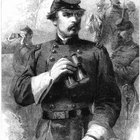The Jumano Indian tribe, now extinct, lived in Texas during the 16th to 18th centuries. They lived peacefully with the Spanish settlers arriving in the area and took pains to mimic the lifestyles they encountered. Not only did they make changes in their clothing choices, but also their language and behavior.
Geography
For more than 200 years, one portion of the tribe lived near the Arkansas River, the other along the Rio Grande. These areas were extremely harsh. Wild animals frequently made their way into the camps, and bugs carried diseases. The Jumano eventually picked clothing that protected them from the elements, such as long skirts for the woman and moccasins for everyone.
Types
Men in the Jumano tribe favored nudity and tattoos, even after the tribe learned how to make their own clothing. At times the men wore moccasins made from deer hide and feathers in their hair. The women were more likely to wear clothing made from deer or buffalo hide. They wore nothing above the waist save for intricate tattoos, but favored long skirts and moccasins.
Features
The Jumano traded animal hides and shells to other tribes for feathers, shells and copper pieces.
Theories/Speculation
Diego Perez, a well-known Spanish settler, hypothesized during the late 16th century that the Jumano tribe mimicked the behavior of villagers living in nearby Patarabuey. Perez wrote that the men acted and wore clothing similar to the settlers. He also believed that the tribe adapted its language to be more like that of settlers living near Rio Concho.
Considerations
Another part of the tribe lived in what is now New Mexico. They wore clothing similar to other Indian tribes, with tight pants and skirts made of deer skin. Some scholars believe this was another sect of the Jumano tribe, while others claim the real Jumano went naked for most of their lives.
Related Articles

About Apache Indian Clothing

What Types of Clothes Do They Wear in ...

Farmer's Wife's Clothes in the 1800s

Hispanic Clothing History

What Type of Clothes Do Mexicans Wear?

What Do Women Pirates Wear?

What Kind of Clothing Do People in Mali ...

1950s Gangster Clothes

Fashion for Teen Men of the '90s

When Did Pierced Ears Originate?

The Significance of Earrings on Men

What Is Trifari Jewelry?

Kids' Clothing During the Medieval ...

The Inuit Diet

Clothing of the Children During the ...

Men's Roles in the 1800s

1930s School Clothes

What Kind of Clothing Do People Wear in ...

History of Body Waxing & Hair Removal

Meat Parts of a Lamb
Writer Bio
Jennifer Eblin has been a full-time freelance writer since 2006. Her work has appeared on several websites, including Tool Box Tales and Zonder. Eblin received a master's degree in historic preservation from the Savannah College of Art and Design.